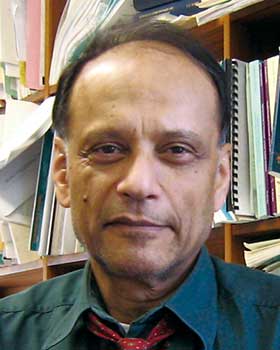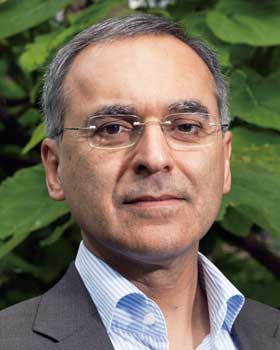3. What nature provides us
Economics and ecology
When Professor Daily was a college student, she studied biology, especially ecology, understood ecosystems and wanted to use her knowledge to conserve nature. However, she gradually came to think that economics may also be necessary for conservation. There is a limit to activities based on goodwill, though, and she began to believe that if people were to realize that damaging nature would be a significant loss for them, or that protecting nature would create substantial business opportunities, they would see nature conservation as more critical.
Ecology and economics are different areas, and they sometimes come into conflict. Of course, some people think that nature conservation and economic growth are entirely incompatible, and they thought this even more so in the 1990s. However, Professor Daily worked to incorporate economics into ecology and, fortunately, some economists were interested in incorporating ecology into economics.
Renowned economist Partha Dasgupta came to Stanford University for a year when Gretchen was a graduate student there. Although nature had gotten ignored as an element in economics, Professor Dasgupta believed that it was critical in evaluating the wealth (and well-being) of a nation and tried to create a new index that included nature. Professor Ehrlich introduced Gretchen to Dasgupta, then who introduced her to Professor Kenneth Arrow, a great economist of the 20th century and a man who contributed to environmental preservation. Professor Daily's conversations with these two renowned academics convinced her that ecology and economics could coexist.
In the mid-1990s, environmental preservation had deteriorated in the United States. People thought that environmental preservation should be considered only when they could afford to do so because it was not profitable, and Professor Daily thought this was a severe problem to society. She felt that biologists had a responsibility to make sure that people understood the importance of nature conservation.

Professor Dasgupta created a new standard, "the Inclusive Wealth Index," to measure the sustainable development of nations. He received the Blue Planet Prize in 2015.
Professor Daily published "Nature's Services" in 1997. In it, she described the benefits we received from nature in scientific terms and explained how economically dependent we were upon nature. She hoped to make it easy for national-level policymakers around the world to understand the importance of nature to a nation's economy.

The cover of "Nature's Services"
Water sources of New York City
A problem with water occurred in New York in the late 1980s. The giant metropolis New York City depended on the Delaware River for its water. The river originates in the Catskill Mountains, a beautiful scenic spot surrounded by nature. Urban development had, however, deteriorated water quality, forcing New York City to consider a new water treatment facility to ensure clean water for its residents.
It would cost 6 to 8 billion dollars for construction and 300 to 500 million dollars for maintenance. New York had to set its water and sewer charges more than double to pay for these costs.
New York City considered this and realized that they could get clean water in the past without a treatment facility because natural purification was enough to filter the water, but that human activity caused this natural purification function to deteriorate. Instead of using the money to build a water treatment facility, they decided to use it to restore the natural functions.
New York City started encouraging people engaged in agriculture and forestry around the Delaware River to conserve nature. For example, they asked farmers to prevent polluted water from flowing into the river. Of course, residents needed to earn money to live, so the city decided to compensate them for their efforts to preserve the natural environment.
These efforts succeeded, and water quality improved. This approach costs only 1 to 1.5 billion dollars, which was much cheaper than building a water treatment facility; and New York City water charges increased only 9%, much less than the initial prediction.
Most importantly, however, this major American city recognized the value of nature, decided to invest in preserving it, and residents agreed with the decision. It is also fortunate that these results got publicized for the world to see.
Nature's work is never done
While continuing her research, Professor Daily worked with journalist Catherine Ellison to interview people engaged in nature conservation all around the world. They published a book of these interviews entitled "The New Economy of Nature: The Quest to Make Conservation Profitable" in 2001. In the book, they introduced people who worked to solve water quality issues in New York City.
At the beginning of the book, Professor Daily included the proverb, "a woman's work is never done." Although women's work at home is essential, involves heavy labor and no breaks, it is unpaid and not adequately recognized.
Professor Daily thought the benefits we receive from nature were very similar to women's work. Forests, for example, provide food and water, prevent disasters, and even give us comfort; but while Mother Nature continues providing significant benefits, we do not pay for them. This fact explains why we have failed to appreciate the value of nature for so long.
We gradually began to recognize and respect the value of women's work and started to talk about what the dollar value of women's work would be if that work were being performed in the free market. Professor Daily felt that the benefits of nature should also be recognized in the same way as women's work was coming to be understood.
Around that time, recognition of the value of ecosystems increased around the world. The Millennium Ecosystem Assessment conducted by the United Nations from 2001 and 2005 evaluated the impact of changes in ecosystems on human life. Professor Daily also participated in the evaluation and played a significant role.
The results showed that ecosystems around the globe have deteriorated. This deterioration caused a decrease in the benefits we receive from these ecosystems, and we needed to take measures to stop it. In response, an environmental economist, Pavan Sukhdev, took the initiative in implementing the Economics of Ecosystems and Biodiversity (TEEB) project. He had served as a board member of Deutsche Bank from 2007 and 2010. The TEEB project has continued on a global scale.

Pavan Sukhdev worked to disseminate green accounting to measure the economic value of nature. He received the Blue Planet Prize in 2016.
Should wildland be protected more than anything else?
Some have criticized Professor Daily for focusing on countryside nature in biospheres inhabited by humans rather than on untouched wildlands.
In fact, few wildlands remain, and they require urgent protection.
Ecosystems continued functioning since long before humans existed and they are not only for humans despite that human cannot live without the benefits of ecosystems. Professor Daily understood this.
She believed it was essential to care for nature in the countryside. The majority of nature is not in nature reserves; and along with increases in the global population, some countries have even decreased the area devoted to nature reserves. If we focus on nature reserves alone, we tend to neglect the rest of nature.
Professor Daily wanted to protect nature where people require the benefits of the land and water to live. She also thought to explain the value of nature in an easy-to-understand way (for example, putting a price tag on nature) would be a shortcut to encouraging conservation.
She was anxious about the deteriorating ecosystems; however, she also found hope because people started recognizing their value. Professor Daily decided to take the next step in advancing the movement, which we will introduce in the following chapter.








